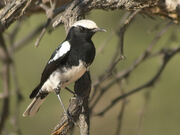| Automatic taxobox help |
|---|
Thanks for creating an automatic taxobox. We don't know the taxonomy of "Oenanthe".
|
| Common parameters |
|
| Helpful links |
| Wheatears | |
|---|---|
| File:Oenanthe oenanthe 01 II.jpg | |
| Northern Wheatear (male) | |
| Scientific classification | |
| Unrecognized taxon (fix): | Oenanthe |
| Species | |
|
See text. | |
The wheatears (/ˈhwiːtɪər/) are passerine birds of the genus Oenanthe. They were formerly considered to be members of the thrush family Turdidae, but are now more commonly placed in the flycatcher family Muscicapidae. This is an Old World group, but the Northern Wheatear has established a foothold in eastern Canada and Greenland and in western Canada and Alaska.
Etymology[]
The name "wheatear" is not derived from "wheat" or any sense of "ear", but is a 16th-century linguistic corruption of "white" and "arse", referring to the prominent white rump found in most species.[1]
Oenanthe is also the name of a plant genus, the water dropworts, and is derived from the Greek oenos (οίνος) "wine" and anthos (ανθός) "flower". In the case of the plant genus, it refers to the wine-like scent of the flowers.[2] In the case of the wheatear, it refers to the Northern Wheatear's return to Greece in the spring just as the grapevines blossom.[3]
Description[]
Most species have characteristic black and white or red and white markings on their rumps or their long tails. Most species are strongly sexually dimorphic; only the male has the striking plumage patterns characteristic of the genus, though the females share the white or red rump patches.
Species list[]

Mountain Wheatear
There are 27 wheatear species [4]:
- Northern Wheatear, Oenanthe oenanthe
- Capped Wheatear, Oenanthe pileata
- Red-breasted Wheatear, Oenanthe bottae
- Heuglin's Wheatear, Oenanthe heuglini
- Isabelline Wheatear, Oenanthe isabellina
- Hooded Wheatear, Oenanthe monacha
- Desert Wheatear, Oenanthe deserti
- Cyprus Wheatear, Oenanthe cypriaca
- Pied Wheatear, Oenanthe pleschanka
- Black-eared Wheatear, Oenanthe hispanica
- Somali Wheatear, Oenanthe phillipsi
- Brown-tailed Rockchat, Oenanthe scotocerca
- Sombre Rockchat, Oenanthe dubia
- Red-rumped Wheatear, Oenanthe moesta
- Familiar Chat, Oenanthe familiaris
- Blackstart, Oenanthe melanura
- Brown Rockchat, Oenanthe fusca
- Variable Wheatear, Oenanthe picata
- White-crowned Wheatear, Oenanthe leucopyga
- Black Wheatear, Oenanthe leucura
- Hume's Wheatear, Oenanthe albonigra
- Kurdish Wheatear, Oenanthe xanthoprymna
- Red-tailed Wheatear, Oenanthe chrysopygia
- Finsch's Wheatear, Oenanthe finschii
- Mourning Wheatear, Oenanthe lugens
- Abyssinian Wheatear, Oenanthe lugubris
- Arabian Wheatear, Oenanthe lugentoides
Behaviour[]
Wheatears are terrestrial insectivorous birds of open, often dry, country. They often nest in rock crevices or disused burrows. Northern species are long-distance migrants, wintering in Africa.
References[]
- ^ "Wheatear". Merriam Webster Online. Retrieved 13 May 2010.
- ^ "Dropwort, Hemlock Water". A Modern herbal. Botanical.com. Retrieved 2008-02-05.
- ^ "Northern Wheatear". eNature. Retrieved 2008-02-05.
- ^ John H. Boyd III (December 14, 2011). "MUSCICAPOIDEA II: Cinclidae, Turdidae, and Muscicapidae". TiF Checklist. Retrieved 19-04-2024. Check date values in:
|access-date=(help)

|
This article is part of Project Bird Genera, a All Birds project that aims to write comprehensive articles on each genus, including made-up genera. |
| This page uses Creative Commons Licensed content from Wikipedia (view authors). Please help by writing it in the style of All Birds Wiki! |
